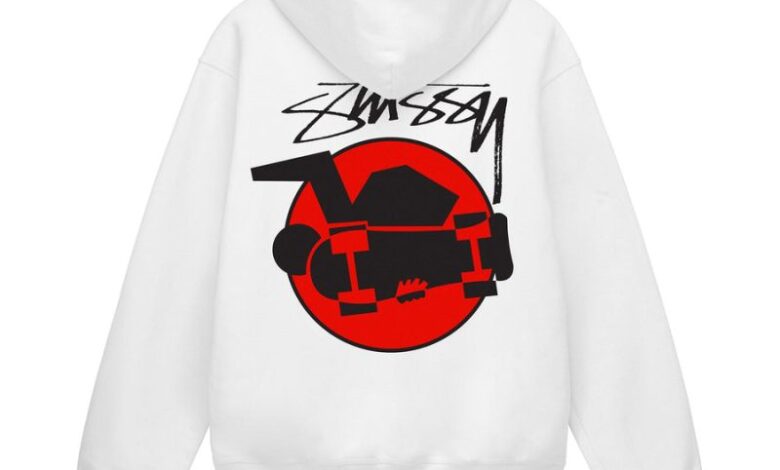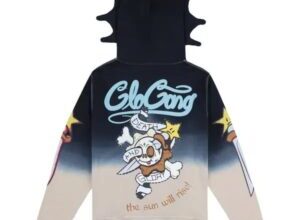The Timeless Legacy of Stussy: From Surfboards to Streetwear Royalty

The Rise of a Cultural Icon
In the vast world of fashion, only a handful of brands have managed to transcend trends, crossing seamlessly from one generation to another without losing their authenticity. Stussy is one of those rare names that has stood the test of time. What started as a humble side project in the surf culture of Southern California during the late 1970s eventually exploded into a global movement that influenced music, skateboarding, hip-hop, and fashion itself. Stüssy’s journey is not just about clothing—it is about culture, community, and a relentless pursuit of originality.
The Humble Beginnings: Surf Culture Meets Creativity
The story of Stüssy begins with Shawn Stüssy, a surfer and board shaper from Laguna Beach, California. In the late 1970s, Shawn was already a respected figure in the local surf scene, shaping high-quality custom surfboards for friends and professional riders. What set him apart was his distinctive signature—his surname scrawled in a graffiti-like hand-drawn style—that he would inscribe on each board. This signature would later become one of the most recognizable logos in streetwear history.
Initially, the clothing side of the business wasn’t even planned. Shawn began experimenting by printing his unique signature logo on T-shirts, caps, and shorts to sell alongside his surfboards. These items weren’t marketed as fashion; they were simply merchandise, created to complement his surfboard sales. Yet, these pieces struck a chord with the surf community. They were casual, stylish, and effortlessly cool—an aesthetic that reflected the laid-back but rebellious nature of California surf culture.
The Birth of Stüssy as a Clothing Brand
By the early 1980s, Shawn realized that his logo and designs were resonating far beyond the surf world. Together with his business partner Frank Sinatra Jr. (no relation to the singer), he officially launched Stüssy as a clothing brand in 1984. This move marked a pivotal moment, as Stüssy began to distance itself from just surf gear and evolved into a fully-fledged streetwear label.
What made Stüssy different from traditional fashion houses was its ability to blend various subcultures into one cohesive style. Surfing, skateboarding, reggae, punk, and hip-hop all had their place in Stüssy’s DNA. Instead of appealing to just one market, the brand created a melting pot of influences that felt inclusive and exciting. It spoke to a generation of young people who didn’t want to be confined to labels but instead wanted to express themselves across multiple cultural spheres.
The Power of the Logo: A Symbol of Rebellion
At the heart of Stüssy’s success lies its iconic logo. Shawn’s graffiti-inspired scrawl became instantly recognizable and symbolic of authenticity and rebellion. Unlike luxury fashion logos that relied on prestige and heritage, the Stüssy signature felt raw, organic, and accessible. It wasn’t polished or corporate; it was real.
This logo became a unifying element across the brand’s diverse product lines. Whether on a plain white T-shirt, a snapback hat, or a hoodie, the Stüssy signature carried weight. It became a badge of belonging for those who understood the brand’s ethos. In many ways, it was one of the first examples of how a simple logo could build a community around clothing—a principle that modern streetwear giants like Supreme and Off-White would later replicate.
Stüssy and the International Stüssy Tribe
Perhaps one of the most genius moves in Stüssy’s history was the creation of the International Stüssy Tribe (IST) in the late 1980s. This was not just a marketing gimmick but a cultural statement. The IST was a collective of DJs, musicians, artists, skaters, and influencers from around the world who were aligned with the brand’s values. Members included figures like Hiroshi Fujiwara in Japan, Alex Turnbull in London, and James Jebbia, who would later go on to found Supreme in New York.
The IST helped spread Stüssy’s influence across borders, turning it from a California surf brand into a global streetwear powerhouse. Each member represented their city while wearing Stüssy, and in doing so, they built bridges between cultures. This global outreach was revolutionary for its time, creating an interconnected street culture long before social media existed.
Defining the Streetwear Blueprint
By the 1990s, Stussy Clothing was no longer just a brand—it was a movement. Its collaborations, grassroots marketing, and ability to connect with youth culture became the blueprint for what we now call streetwear. While other fashion houses were focused on seasonal collections and runway shows, Stüssy thrived by releasing limited products, creating scarcity, and building anticipation.
The brand also excelled in collaborations long before they became a mainstream marketing strategy. Stüssy worked with artists, musicians, and other brands, blurring the line between fashion and culture. These collaborations weren’t about chasing clout but about genuine creative synergy. As a result, Stüssy maintained credibility within the communities it served.
Stüssy and Music: A Cultural Symbiosis
Music played a critical role in Stüssy’s evolution. From reggae and punk to hip-hop and electronic, the brand was always closely aligned with the sounds of youth culture. DJs wore Stüssy at underground parties, rappers flaunted it in music videos, and skaters brought it into their rebellious world. This association with music gave Stüssy an edge that traditional fashion brands simply couldn’t replicate.
The International Stüssy Tribe often hosted events and parties where DJs spun records, blending fashion with nightlife. These gatherings weren’t just about clothes—they were about community, creativity, and cultural exchange. It was this holistic approach that cemented Stüssy’s role as more than just a label but as a cultural catalyst.
The Challenges and Evolution of the 2000s
Like any brand with decades of history, Stüssy also faced challenges. By the early 2000s, streetwear had evolved, and many newer brands were entering the scene. The rise of Supreme, BAPE, and others shifted attention away from Stüssy, and the brand risked being overshadowed. Some critics argued that Stüssy had lost its edge, while others believed it was simply adjusting to a new era.
However, Stüssy’s resilience proved unmatched. Rather than trying to compete directly with newer brands on hype alone, Stüssy doubled down on its legacy. It continued to produce timeless designs while collaborating strategically with both emerging and established partners. This balance of heritage and innovation allowed Stüssy to remain relevant even in a crowded market.
Collaborations That Defined an Era
One of the strongest aspects of Stüssy’s modern revival has been its collaborations. From Nike and Converse to Dior and Supreme, Stüssy has consistently found ways to merge its laid-back streetwear aesthetic with high fashion and sportswear giants. These partnerships not only brought new attention to the brand but also solidified its role as a pioneer.
For example, the Stüssy x Nike collaborations have been particularly impactful. Sneakers like the Stüssy Dunk High and the Stüssy Air Zoom Spiridon became instant classics, blending Stüssy’s surf-skate DNA with Nike’s athletic innovation. Collaborations with luxury houses like Dior also demonstrated Stüssy’s ability to move fluidly between underground streetwear and high-end fashion, something few brands have successfully achieved.
The Role of Stüssy in Modern Streetwear
Today, streetwear is a multi-billion-dollar industry, with brands like Supreme, Off-White, and Palace dominating headlines. Yet, Stüssy remains a cornerstone, often credited with laying the foundation for the movement. Its influence can be seen everywhere—from the prevalence of logo-heavy designs to the culture of limited releases and collaborations.
What sets Stüssy apart in the modern era is its ability to stay authentic while adapting to new generations. Young people who discover Stüssy today may not know its full history, but they are drawn to its timeless designs and cultural cachet. For older fans, Stüssy represents nostalgia and a connection to the roots of streetwear. In this way, the brand successfully bridges the gap between past and present.
Stüssy’s Global Reach and Cultural Impact
From Tokyo to London, New York to Paris, Stüssy has become a global language of style. Its stores and pop-ups are cultural hubs where fashion, art, and music intersect. The brand’s impact is not just measured in sales but in how it has shaped identity and community across the world.
In Japan, for instance, Stüssy has been particularly influential. The Japanese streetwear scene embraced the brand early on, and its stores there remain cultural landmarks. Similarly, in Europe, Stüssy has cultivated a dedicated following by aligning with local subcultures and creatives. This global adaptability is one of the key reasons why Stüssy continues to thrive decades after its inception.
Sustainability and the Future of Stüssy
As the fashion industry evolves, sustainability has become a pressing concern. While Stüssy has historically been more focused on cultural authenticity than environmental messaging, it has begun to adopt practices that align with modern values. Limited production runs, durable materials, and timeless designs all contribute to a more sustainable approach compared to fast fashion brands.
Looking ahead, the future of Stüssy lies in its ability to remain both timeless and innovative. The brand has proven time and again that it can weather cultural shifts and remain at the forefront of fashion. With its deep-rooted history and loyal community, Stüssy is poised to remain a leader in streetwear for years to come.
More Than Just Clothing
Stussy Shirt is not just a brand—it is a cultural phenomenon that has left an indelible mark on fashion, music, and youth culture. From its surfboard roots in California to its global dominance today, Stüssy has consistently embodied authenticity, creativity, and community. Its iconic logo is more than just a signature; it is a symbol of belonging for generations of people who value individuality and cultural connection.
In a world where trends come and go at lightning speed, Stüssy’s legacy reminds us that true style is not about following fashion—it is about creating it. The brand’s story is a testament to the power of authenticity, proving that when culture and creativity align, the result can be nothing short of legendary.





